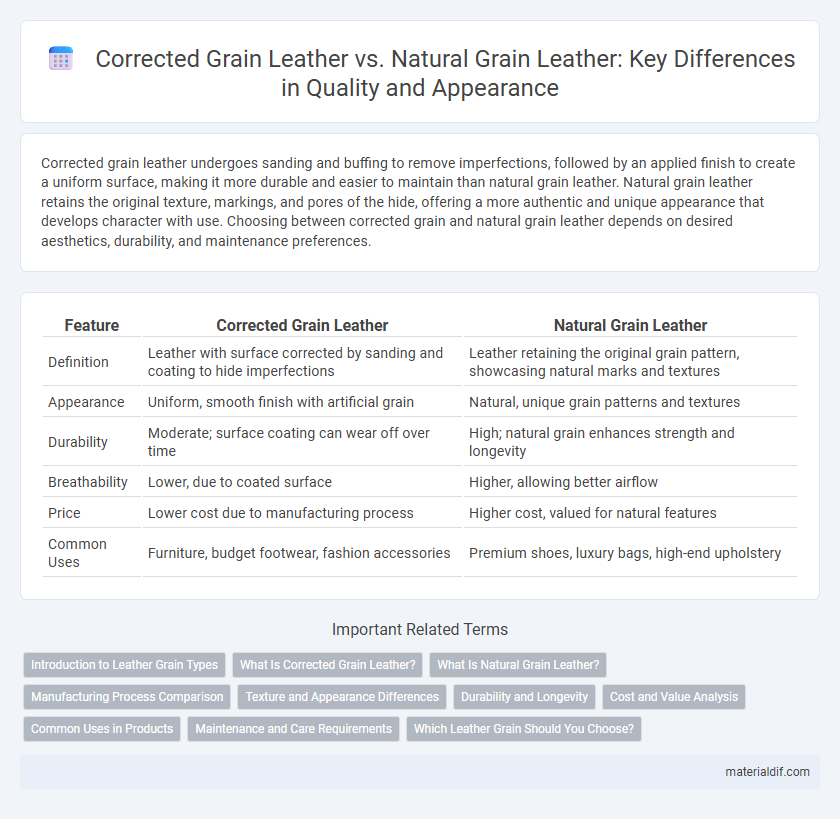Corrected grain leather undergoes sanding and buffing to remove imperfections, followed by an applied finish to create a uniform surface, making it more durable and easier to maintain than natural grain leather. Natural grain leather retains the original texture, markings, and pores of the hide, offering a more authentic and unique appearance that develops character with use. Choosing between corrected grain and natural grain leather depends on desired aesthetics, durability, and maintenance preferences.
Table of Comparison
| Feature | Corrected Grain Leather | Natural Grain Leather |
|---|---|---|
| Definition | Leather with surface corrected by sanding and coating to hide imperfections | Leather retaining the original grain pattern, showcasing natural marks and textures |
| Appearance | Uniform, smooth finish with artificial grain | Natural, unique grain patterns and textures |
| Durability | Moderate; surface coating can wear off over time | High; natural grain enhances strength and longevity |
| Breathability | Lower, due to coated surface | Higher, allowing better airflow |
| Price | Lower cost due to manufacturing process | Higher cost, valued for natural features |
| Common Uses | Furniture, budget footwear, fashion accessories | Premium shoes, luxury bags, high-end upholstery |
Introduction to Leather Grain Types
Corrected grain leather undergoes sanding and buffing to remove imperfections, resulting in a smoother, more uniform surface ideal for consistent finishes. Natural grain leather retains its original texture and markings, showcasing unique characteristics and breathability that highlight the leather's authenticity. Understanding these differences helps consumers choose between durability and natural aesthetics in leather products.
What Is Corrected Grain Leather?
Corrected grain leather refers to leather that has been mechanically buffed or sanded to remove imperfections from the surface, then coated with an artificial grain layer to create a uniform appearance. This type of leather often receives additional pigmentation and protective finishes to enhance durability and aesthetic appeal. It contrasts with natural grain leather, which retains the original surface texture and markings, preserving the hide's authentic qualities.
What Is Natural Grain Leather?
Natural grain leather is made from the uppermost layer of the animal hide, retaining all the natural grain patterns and imperfections that showcase its authenticity and durability. This type of leather is prized for its breathability, strength, and ability to develop a unique patina over time due to the presence of the original pores and fibers. Unlike corrected grain leather, natural grain leather undergoes minimal surface treatment, preserving its natural texture and enhancing its premium quality.
Manufacturing Process Comparison
Corrected grain leather undergoes extensive sanding and buffing to remove natural imperfections, followed by an artificial grain layer application to achieve uniform texture and color, enhancing durability and appearance consistency. Natural grain leather retains the original animal hide surface, preserving unique markings, pores, and textures through minimal processing, which maintains breathability and natural aesthetics. The manufacturing process of corrected grain leather emphasizes surface correction and finishing, whereas natural grain leather focuses on maintaining the hide's inherent characteristics with limited alteration.
Texture and Appearance Differences
Corrected grain leather undergoes extensive buffing and coating to mask surface imperfections, resulting in a uniform texture with an artificial finish, often appearing smoother and less natural. Natural grain leather retains the original hide's surface, showcasing unique markings and a richer, more authentic texture that develops character over time. The appearance of natural grain leather is more varied and breathable, while corrected grain leather offers a consistent look but may lack the distinctive qualities of genuine animal hide.
Durability and Longevity
Corrected grain leather undergoes extensive sanding and buffing to remove imperfections, resulting in a more uniform surface but slightly reduced durability compared to natural grain leather. Natural grain leather retains the original texture and strength of the hide, offering superior longevity and resistance to wear and tear. For applications demanding maximum durability and long-lasting performance, natural grain leather is the preferred choice.
Cost and Value Analysis
Corrected grain leather undergoes surface sanding and coating to hide imperfections, resulting in a lower production cost and a more affordable price point compared to natural grain leather. Natural grain leather retains its original texture and durability, often commanding higher prices due to its premium quality and long-lasting value. While corrected grain leather offers budget-friendly options, natural grain leather delivers superior longevity and a richer aesthetic, making it a better investment for quality-focused buyers.
Common Uses in Products
Corrected grain leather is frequently used in furniture, handbags, and footwear due to its uniform appearance and enhanced durability from surface sanding and embossing. Natural grain leather, prized for its breathability and unique textures, is commonly found in high-end jackets, luxury car interiors, and premium accessories. Both types cater to different market demands, with corrected grain prioritizing consistency and natural grain emphasizing authenticity.
Maintenance and Care Requirements
Corrected grain leather requires more frequent cleaning and conditioning due to its sanded surface, which lacks the protective natural grain and finish, making it more susceptible to wear and stains. Natural grain leather maintains its durability and breathability due to the intact top layer, allowing for easier upkeep with occasional cleaning and conditioning to preserve its natural oils. Proper maintenance for both types involves avoiding excessive moisture and using leather-specific care products to extend longevity and appearance.
Which Leather Grain Should You Choose?
Corrected grain leather undergoes sanding and buffing to remove imperfections, then is coated with a synthetic finish, resulting in a more uniform appearance ideal for durability and easy maintenance. Natural grain leather retains the original surface texture and markings, offering breathability, a unique character, and higher quality suited for premium products. Choose natural grain leather for authenticity and aging beauty, while corrected grain leather suits budget-friendly, consistent finishes.
Corrected Grain Leather vs Natural Grain Leather Infographic

 materialdif.com
materialdif.com